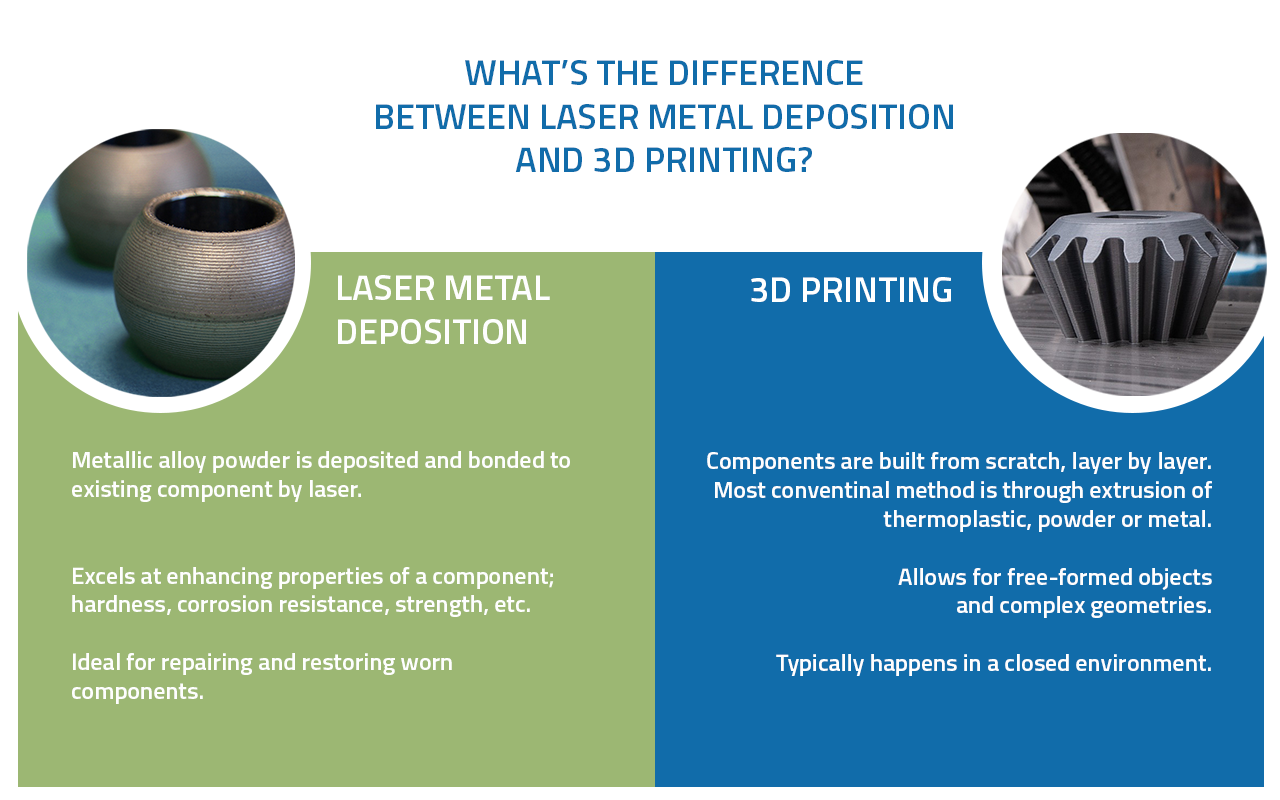
We’re often asked to compare laser metal deposition and 3D printing. Both processes can be labeled “additive manufacturing,” but do the similarities end there? In this article, we’ll explore how each process works, and the different applications for each technology.
What is Laser Metal Deposition?
Laser metal deposition (LMD) is an additive manufacturing process in which metal is heated by laser and deposited onto a metallic substrate, layer by layer. It is also known as laser cladding, although technically, laser cladding is a type of laser metal deposition. Laser metal deposition is used to manufacture, strengthen, and restore parts such as turbine blades, pump shafts, and pressure vessels, just to name a few.
Let’s take a closer look at how the process works. It starts with the laser which heats the surface of the workpiece. A nozzle then feeds powdered metal in the melting pool, fusing it to create a metallurgical bond with the substrate. The process is repeated, building one layer at a time. The result? Parts that are strong, with incredible wear resistance due to increased hardness. Popular powders (or wire) used in laser metal deposition include Inconel, cobalt, Hastelloy, tool steels and many other metals including super alloys.
The Process is the Finish!
Laser metal deposition is a fantastic choice for protecting components that are hard-working or difficult to replace. The finish created by laser metal deposition is extremely durable, and ideal for applications that are subject to intense abrasion, such as downhole drilling or mining operations. The treated surfaces also boast strong corrosion and erosion resistance, which is required for heavy duty critical components found in aerospace, power generation, valve, and similar demanding applications.
Is Laser Metal Deposition the same as 3D Printing?
While the processes appear similar, laser metal deposition and 3D printing both excel at completely different things. For our example, we’ll examine the more conventional approach to 3D printing, which involves the extrusion of thermoplastic material, powder, or metal.
3D printing builds components in layers, just like laser metal deposition. However, 3D printing is better suited for creating free formed objects, as well as those with more complex geometries. Such objects may not be ideal candidates for laser metal deposition.
Additionally, 3D printing typically happens in a closed environment, so dimensional capabilities are restricted by the size of the system’s enclosure. At American Cladding Technologies, laser metal deposition is limited only by the size of our facility. The components we service can be as small as a half dollar, or as large as 40 feet long, 6 feet in diameter and 6 tons in weight.
Laser Metal Deposition: The Choice for Durability, Longevity and Strength
Whether you need to process new parts, restore old ones, or bring obsolete components back to life, laser metal deposition will often outperform other methods. For instance, when used on boiler tubes for chemical processing or waste energy, those coated with Inconel 625 will last 6 times longer that than those without treatment. Laser metal deposition is a fast and efficient process that delivers durability and longevity to many hard-working, mission critical components in the most demanding applications.
